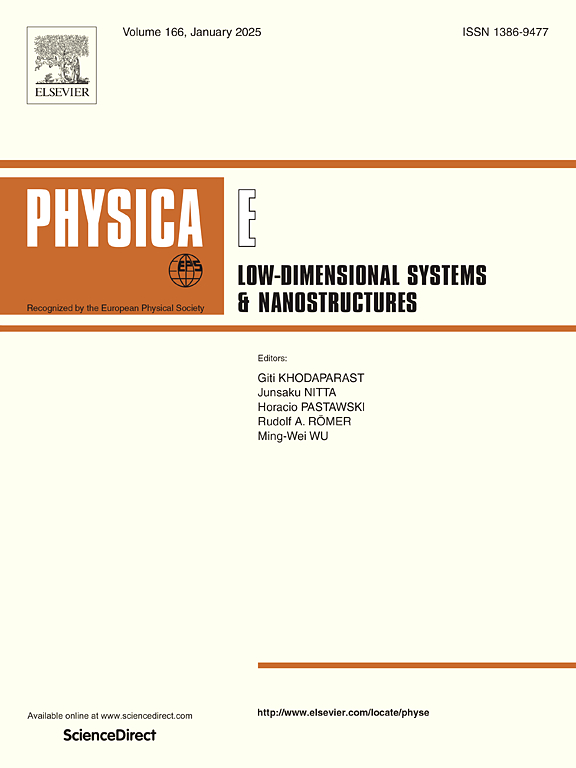Multifunctional metamaterials based on VO2 for realizing dual-band absorption, cross-polarization conversion and asymmetric transmission
IF 2.9
3区 物理与天体物理
Q3 NANOSCIENCE & NANOTECHNOLOGY
Physica E-low-dimensional Systems & Nanostructures
Pub Date : 2025-06-09
DOI:10.1016/j.physe.2025.116312
引用次数: 0
Abstract
In this work, we theoretically and numerically demonstrate a vanadium dioxide (VO2)-based multifunctional metamaterial capable of dynamically switching between diverse operational modes in the terahertz band. By exploiting the unique phase-transition properties of VO2, the presented metamaterial can achieve multiple tunable functionalities, including perfect absorption, cross-polarization conversion and asymmetric transmission (AT). When VO2 is in the metallic state, the metamaterial acts as a dual-band perfect absorber with wide-angle and polarization insensitivity characteristics. Meanwhile, the metamaterial serves as a polarization converter, which can fulfill linear-to-linear (LTL) and linear-to-circular (LTC) polarization conversion. Specifically, the LTL polarization conversion rate reaches ∼100 % at 2.19 THz and 2.94 THz. And the ellipticity of the LTC polarization conversion is ±1 at the frequency range of 2.37–2.66 THz as well as the frequency points of 2.09 THz and 3.13 THz, indicating that the linear polarized waves can be completely converted into circularly polarized waves. Moreover, when VO2 is in its insulating phase, the designed metamaterial exhibits an AT effect with an efficiency of 0.71. This innovative design offers valuable insights for the potential applications of multifunctional optoelectronic devices in the terahertz region.
基于VO2的多功能超材料,实现双波段吸收、交叉极化转换和不对称传输
在这项工作中,我们从理论上和数值上证明了一种基于二氧化钒(VO2)的多功能超材料,该材料能够在太赫兹波段的不同工作模式之间动态切换。利用VO2独特的相变特性,所制备的超材料可以实现完美吸收、交叉极化转换和不对称传输等多种可调功能。当VO2处于金属态时,该超材料作为双波段完美吸收体,具有广角和偏振不敏感特性。同时,该超材料还可以作为偏振变换器,实现线性到线性(LTL)和线性到圆(LTC)的偏振转换。具体来说,LTL极化转化率在2.19 THz和2.94 THz达到了~ 100%。在2.37 ~ 2.66 THz频率范围以及2.09和3.13 THz频率点,LTC极化转换的椭圆率为±1,表明线极化波可以完全转换为圆极化波。此外,当VO2处于绝缘相时,所设计的超材料具有效率为0.71的AT效应。这一创新设计为太赫兹区域多功能光电器件的潜在应用提供了有价值的见解。
本文章由计算机程序翻译,如有差异,请以英文原文为准。
求助全文
约1分钟内获得全文
求助全文
来源期刊
CiteScore
7.30
自引率
6.10%
发文量
356
审稿时长
65 days
期刊介绍:
Physica E: Low-dimensional systems and nanostructures contains papers and invited review articles on the fundamental and applied aspects of physics in low-dimensional electron systems, in semiconductor heterostructures, oxide interfaces, quantum wells and superlattices, quantum wires and dots, novel quantum states of matter such as topological insulators, and Weyl semimetals.
Both theoretical and experimental contributions are invited. Topics suitable for publication in this journal include spin related phenomena, optical and transport properties, many-body effects, integer and fractional quantum Hall effects, quantum spin Hall effect, single electron effects and devices, Majorana fermions, and other novel phenomena.
Keywords:
• topological insulators/superconductors, majorana fermions, Wyel semimetals;
• quantum and neuromorphic computing/quantum information physics and devices based on low dimensional systems;
• layered superconductivity, low dimensional systems with superconducting proximity effect;
• 2D materials such as transition metal dichalcogenides;
• oxide heterostructures including ZnO, SrTiO3 etc;
• carbon nanostructures (graphene, carbon nanotubes, diamond NV center, etc.)
• quantum wells and superlattices;
• quantum Hall effect, quantum spin Hall effect, quantum anomalous Hall effect;
• optical- and phonons-related phenomena;
• magnetic-semiconductor structures;
• charge/spin-, magnon-, skyrmion-, Cooper pair- and majorana fermion- transport and tunneling;
• ultra-fast nonlinear optical phenomena;
• novel devices and applications (such as high performance sensor, solar cell, etc);
• novel growth and fabrication techniques for nanostructures

 求助内容:
求助内容: 应助结果提醒方式:
应助结果提醒方式:


